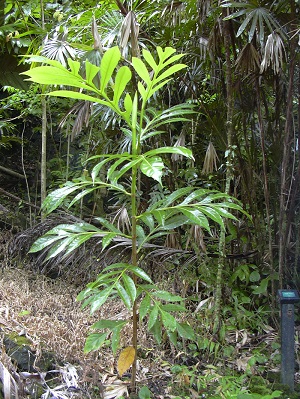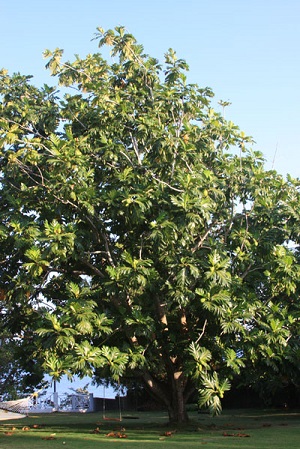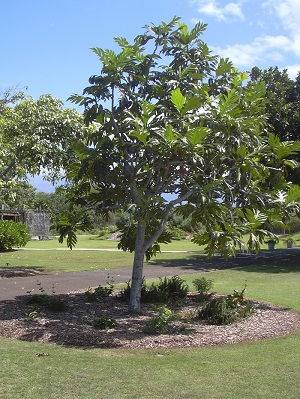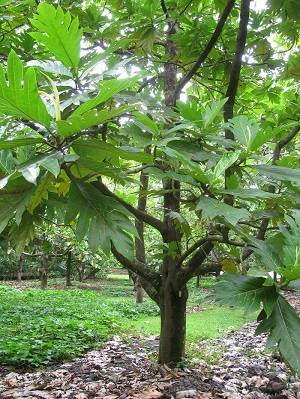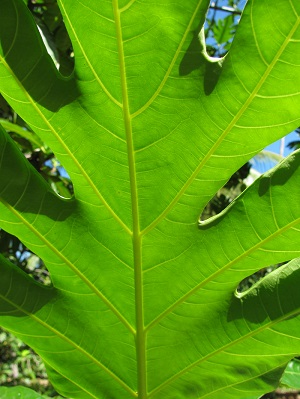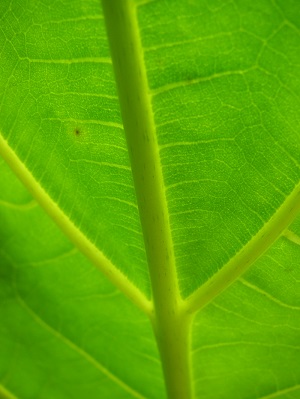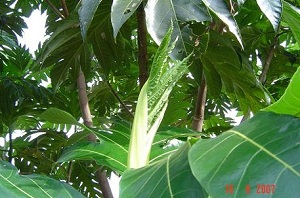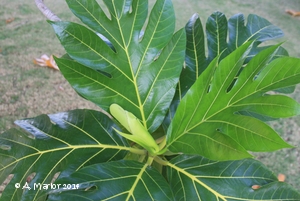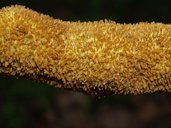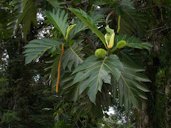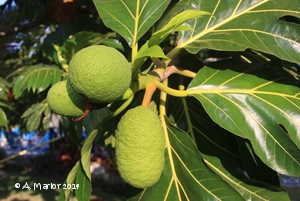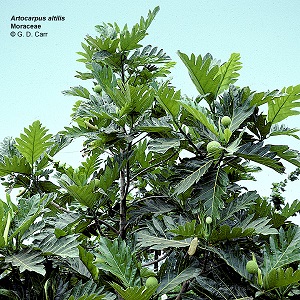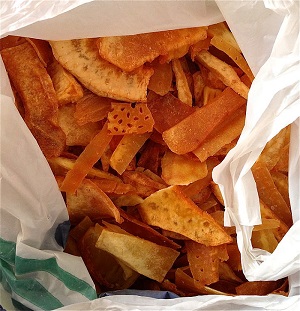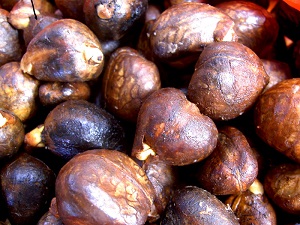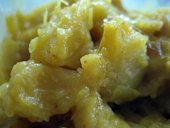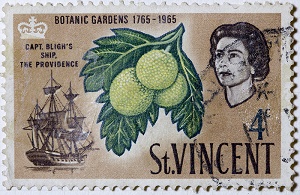| Breadfruit - Artocarpus altilis | |||||||||||||||||||||||||||||||||||||||||||||
|---|---|---|---|---|---|---|---|---|---|---|---|---|---|---|---|---|---|---|---|---|---|---|---|---|---|---|---|---|---|---|---|---|---|---|---|---|---|---|---|---|---|---|---|---|---|
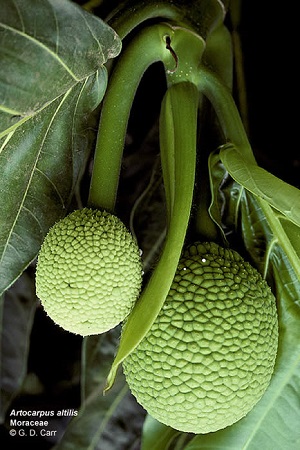 Fig. 1  Breadfruit, Artocarpus altilis 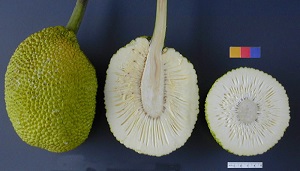 Fig. 2  The fruit of the breadfruit tree - whole, sliced lengthwise and in cross-section 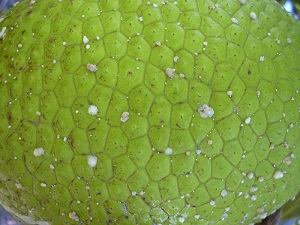 Fig. 3  Close up of skin 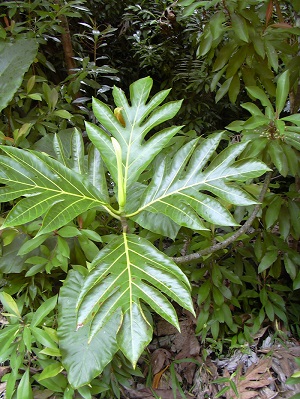 Fig. 4  A. altilis (leaves). Maui, Keanae Arboretum, Hawai'i. 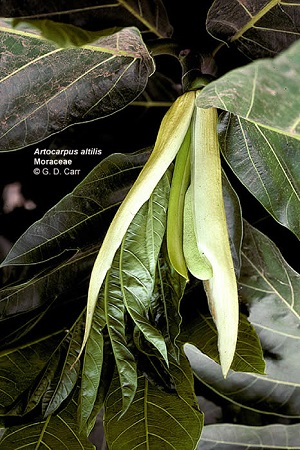 Fig. 14  Breadfruit flower 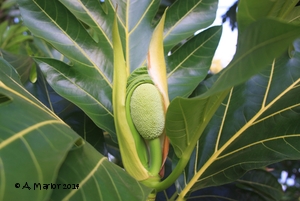 Fig. 15  Female flower 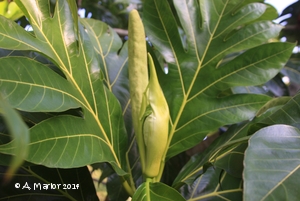 Fig. 16  Male and female flowers 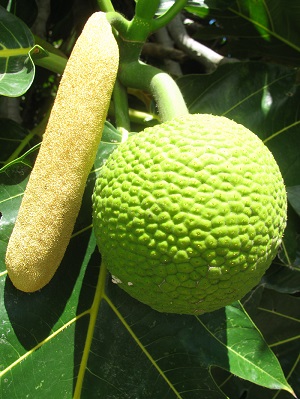 Fig. 17  Male flower and immature fruit 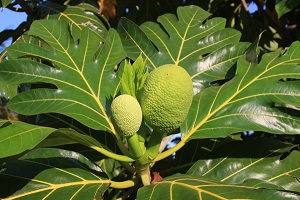 Fig. 21  Fruit starting 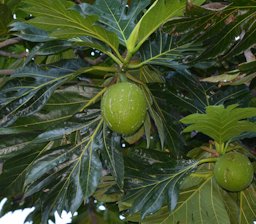 Fig. 22  Breadfruit, A. altilis  Fig. 23  A. altilis (Ulu, breadfruit). Fruit and leaves. Keopuolani Park, Maui, Hawai'i. 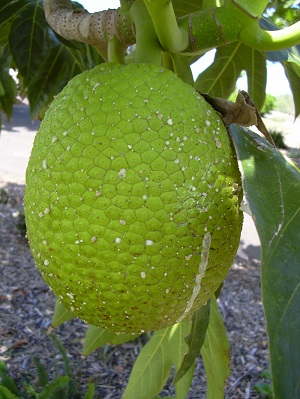 Fig. 24  Maturity is indicated by the appearance of small drops of latex on the surface 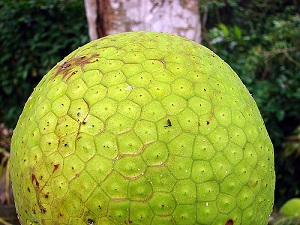 Fig. 25  A mature breadfruit in Sarawak, where it is known as Sukun. This is an ancient cultivar, spread mainly by planting root cuttings. 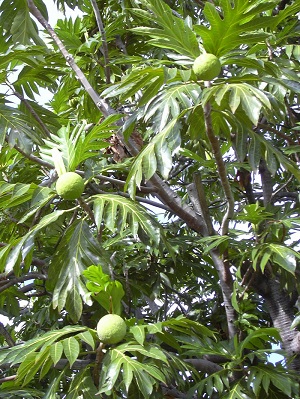 Fig. 26  A. altilis (leaves and fruit). Maui, Puehuihueiki cemetary Lahaina, Hawai'i. 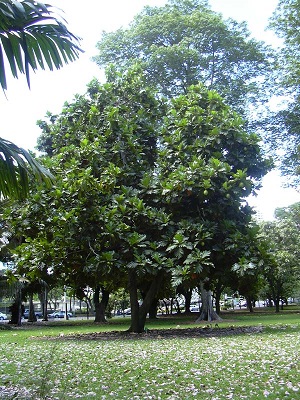 Fig. 30  Breadfruit tree planted in Honolulu, Hawai'i 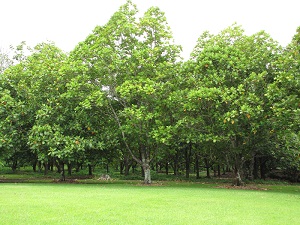 Fig. 31  A. altilis ('Ulu, breadfruit). Fruiting habit. Kahanu Gardens Hana, Maui, Hawai'i. 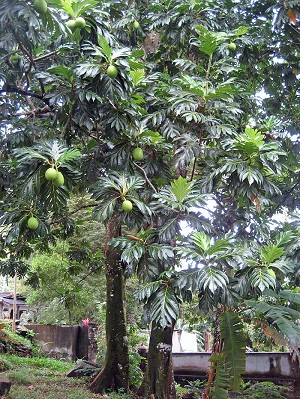 Fig. 32  Mature tree with fruit A. altilis ("Breadfruit") in Mahe, Seychelles 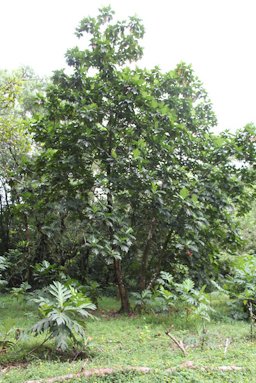 Fig. 33  A large breadfruit being used as a mother tree in the Pohnpei forestry nursery. Breadfruit is seedless so it is propagated vegetatively. The small breadfruit trees here under the mother tree here are root sprouts. When a customer comes to the nursery the workers cut a section of the root with a shoot and give it to him. Pohnpei, Micronesia.  Fig. 34  Trunk 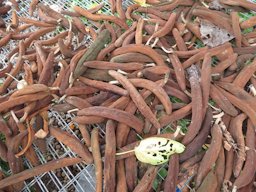 Fig. 35  A. altilis (Ulu, breadfruit). Male flowers used as mosquito punks. Maui Nui Botanical Garden Kahului, Maui, Hawaii. 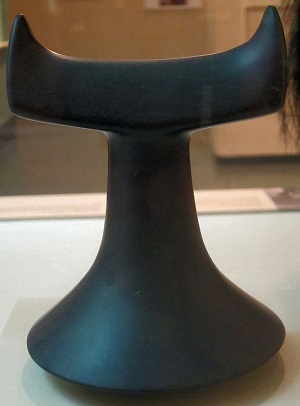 Fig. 39  A polished basalt breadfruit pounder used by the Tahitian people of French Polynesia Fig. 40  Vase with breadfruit design, Hawaiian Potters Guild, c. 1940, glazed earthenware, Honolulu Museum of Art 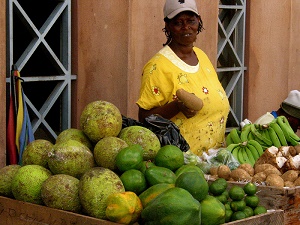 Fig. 43  Breadfruit and other produce on sale in Kingstown market, Jamaica | Scientific
name Artocarpus altilis (Parkinson) Fosberg Common names English: breadfruit, dugdug ; French: arbre à pain; German: Brotfruchtbaum; Spanish: fruta de pan, árbol del pan; Hawai'i, Samoa, Rotuma, Tuvalu: 'Ulu; Society Islands: Uru; Cook Islands: Kuru; Fiji: Uto, Buco; Federate States of Micronesia, Kiribati Marshalls, Marquesas, Tonga, Tuvalu: Mei, Mai; Malaysia: sukun; Palau: Meduu; Kosrae: Mos; Papua New Guinea: Kapiak; Solomon Islands: Bia, Bulo, Nimbalu; Vanuatu: Beta; Portuguese: fruta-pão; Philippines: Rimas; Indonesia: Sukun 2,6 Synonyms A. communis J.R. & G. Forster; A. communis var. communis J.R. Forst. & G. Forst., A. camansi Blanco; A. incisus (Thunb.) L. f., Radermachia incisa Thunb. 6,10 Relatives Champedak, A. integer Merr.; jackfruit, A. heterophyllus; lakoocha, A. lakoocha Roxb.; kwai muk, A. hypargyraeus; marang, A. odoratissimus; pingan, A. saraswakensis; butong, A. nitidus; monkey jackfruit, A. rigidus; pedalai, A. sericicarpus; breadnut, Brosimum alicastrum; Pudau, A. kemando; Ficus spp.; Morus spp. 7 Family Moraceae (mulberry family) Origin Polynesia USDA hardiness zones Ultra tropical Uses Fruit; landscape specimen Height Up to 85 ft (26 m) 1 Width 2-6 ft (0.6-1.8 m) 1 Crown Dense, spreading habit Growth rate Fast Longevity Long lived; will be productive for 50 years 1 Trunk/bark/branches Clear trunk to 20 ft (6.1 m); 2-6 in. (5.1-15.2 cm) thick; often buttressed at the base; spreading branches; thick with lateral foliage or slender with foliage at tips 1 Pruning requirement Little pruning required Leaves Evergreen or deciduous based on conditions; ovate; 9-36 in. (23-91 cm) X 8-20 in. (20-51 cm); deeply cut into lobes Flower Male and female (monoecious); tiny flowers Fruit Varies in shape and color; borne singly or in clusters at the tip of the branch Season Fruits most of the year with fruit at different stages of development on the tree USDA Nutrient Content pdf Light requirement Sun Soil tolerances Deep, fertile well-drained soil; great variation in the adaptability of different strains to climatic and soil conditions 1 pH preference 6.1-7.4 9 Drought tolerance Can withstand drought for a few months but will prematurely drop its fruits 9 Aerosol salt tolerance Can tolerate salt spray for brief periods 9 Cold tolerance Will not survive below 40 °F (4.4 °C) Plant spacing 25 ft (7.6 m) Roots No known problem Invasive potential * None reported Known hazard All parts of the tree, including the unripe fruit, are rich in milky, gummy latex 1 Reading Material Artocarpus altilis, World Agroforestree Database Breadfruit, Fruits of Warm Climates The Breadfruit, Manual Of Tropical And Subtropical Fruits Breadfruit Agroforestry Guide, Breadfruit Institute of the National Tropical Botanical Garden pdf Artocarpus altilis, Prosea Foundation Origin Breadfruit originated in the western Pacific, with New Guinea and associated islands such as the Bismarck Archipelago. Few-seeded and seedless forms occur throughout the Pacific Islands, with the greatest diversity found in the eastern Pacific in Polynesia. 12 Until recently, only a small fraction of Pacific breadfruit diversity has been shared outside of the region. More than 200 years ago, fewer than 10 seedless cultivars were transported from French Polynesia and Tonga by the British and French, respectively, to the Caribbean. These seedless cultivars were then introduced to other countries throughout the Neotropics, Africa, and Asia. Breadfruit is now grown in 90 countries. 9 Hawaiian breadfruit; ethnobotany, nutrition, and human ecology, University of Hawai'i at Mānoa pdf A Guide to Artocarpus Fruits, Archives of the Rare Fruit Council of Australia Description The breadfruit tree is handsome and fast growing, reaching 85 ft (26 m) in height, often with a clear trunk to 20 ft (6 m) becoming 2 to 6 ft (0.6-1.8 m) in width and often buttressed at the base, though some varieties may never exceed ¼ or ½ of these dimensions. There are many spreading branches, some thick with lateral foliage-bearing branchlets, others long and slender with foliage clustered only at their tips. In the green stage, the fruit is hard and the interior is white, starchy and somewhat fibrous. When fully ripe, the fruit is somewhat soft, the interior is cream colored or yellow and pasty, also sweetly fragrant. The seeds are irregularly oval, rounded at one end, pointed at the other, about 3/4 in (2 cm) long, dull-brown with darker stripes. In the center of seedless fruits there is a cylindrical or oblong core, in some types covered with hairs bearing flat, brown, abortive seeds about 1/8 in (3 mm) long. The fruit is borne singly or in clusters of 2 or 3 at the branch tips. The fruit stalk (pedicel) varies from 1 to 5 in (2.5-12.5 cm) long. 1
Fig. 5. A. altilis (habit). Maui, Keanae Arboretum, Hawai'i. Fig. 7. Habit. Hawai'i Maui Nui Botanical Garden, Maui, Hawai'i. Fig. 8. Habit. Kahanu Gardens Hana, Maui, Hawai'i. Leaves The leaves, evergreen or deciduous depending on climatic conditions, on thick, yellow petioles to 1 1/2 in (3.8 cm) long, are ovate, 9 to 36 in (22.8-90 cm) long, 8 to 20 in (20-50 cm) wide, entire at the base, then more or less deeply cut into 5 to 11 pointed lobes. They are bright-green and glossy on the upper surface, with conspicuous yellow veins; dull, yellowish and coated with minute, stiff hairs on the underside. 1
Fig. 9,10. A. altilis ('Ulu, breadfruit). Leaf veins. Kahanu Gardens NTBG Kaeleku Hana, Maui, Hawai'i. Fig. 11. Leaf emerging Fig. 13. Leaf internodes Flowers The tree is monoecious (male and female flowers on the same tree) bears a multitude of tiny flowers, the male densely set on a drooping (Fig. 13), cylindrical or club-shaped spike 5 to 12 in (12.5-30 cm) long and 1 to 1 1/2 in (2.5-3.75 cm) thick, yellowish at first and becoming brown. The female are massed in a somewhat rounded or elliptic, green, prickly head, 2 1/2 in (6.35 cm) long and 1 1/2 in (3.8 cm) across, which develops into the compound fruit (or syncarp), oblong, cylindrical, ovoid, rounded or pear shaped, 3 1/2 to 18 in (9-45 cm) in length and 2 to 12 in (5-30 cm) in diameter. 1 The male inflorescence appears first. The male flowers are 5 cm in diameter and up to 45 centimeters long. Thousands of tiny flowers are attached to the spongy core (Fig. ). Female inflorescences consist of 1500-2000 reduced flowers also attached to a spongy core. The flowers fuse together and form the fleshy edible part of the fruit. 2
Fig. 18. Male flower emerging Fig. 19. Close-up of the male flower Fig. 20. Male flower on the left and female flowers on the right Fruit Immature fruit is bright green (Fig. 13) and has not reached full size. It is rubbery and watery even when cooked, lacking the rich flavor and texture of mature fruit. An immature breadfruit will not mature or ripen after picking. Most people who eat immature breadfruit end up not liking it. A ripe breadfruit is soft to the touch with a sweet aromatic fragrance. 3 Breadfruit contains a small amount of white sap, which can stick to knives, pots and steamers. Cutting of the stem immediately after harvest and letting the fruit sit stem end down drains most of the sap. Sap issues can be reduced or eliminated by choosing mature fruit, proper handling, washing and refrigeration. In the kitchen, breadfruit should be soaked for 1–2 minutes in cold, clean water and washed to remove any sap or debris on the skin .3
Varieties An unpublished report of 1921 covered 200 cultivars of breadfruit in the Marquesas. The South Pacific Commission published the results of a breadfruit survey in 1966. In it, there were described 166 named sorts from Tonga, Niue, Western and American Samoa, Papua and New Guinea, New Hebrides and Rotuma. There are 70 named varieties of seeded and seedless breadfruits in Fiji. 1 The cultivars of breadfruit may either be seeded or seedless. The seedless ones contain about 70 per cent edible pulp whsereas the seeded ones contain 30 per cent pulp and 3 per cent edible seeds. The trees of both types are very similar morphologically but the seeded forms are taller and more vigorous. The number of seeds in the seeded forms varies. The seedless variety, considered a sport of the seeded type, is commonly cultivated. A number of seedless clonal cultivars have been selected. 8 The Breadfruit Collection, USDA Tropical Plant Genetic Resources and Diseases Research Culture The breadfruit is adapted to the hot, tropical lowlands. It grows well on a variety of soils as long as they are well-drained. It thrives at temperature between 70–90°F (21-32°C). Temperatures below 41°F (5°C) injure the plants. 8 It will not succeed outdoors anywhere in the continental United States except for sheltered locations in extreme South Florida and the Keys 1 The tree is susceptible to damage by winds, which cause the branches to break, and flowers and young fruits to fall. Breadfruit can be grown on a variety of soils and thrives on alluvial and coastal soils. It does the best in deep, fertile, well-drained sandy loam or clay loam soils. Impeded drainage in the soil stunts the trees and water stagnation around the roots causes premature dropping of fruits. 8 Rain apparently stimulates extension growth, flowering and the rate of growth of the fruit. 10 How to Plant a Breadfruit tree, Breadfruit Institute - National Tropical Botanical Garden pdf Harvesting The fruit matures in nearly three months. Harvesting of fruit is done when it is still hard by lowering and without letting it fall from the tree. Breadfruit seeds are separated from the soft pulp of the harvested ripe fruits. Breadfruit are ready to harvest in the starchy stage when the bumps on the fruit flatten out, the fruit turns light green, and the sap begins to ooze out over the fruit (Fig. 22,24). Picked sooner and the fruit will be useful as a vegetable but will not be starchy. Picked later and the flesh will be soft and sweet and used for desserts. 11 Look for greenish-yellow skin, a smooth surface, and brownish cracking between the surface segments. The fesh inside is firm and creamy white or pale yellow in color. Some varieties vary in maturity indicators. 3 Pollination Honeybees have been observed actively working the male inflorescence and collecting pollen, especially from fertile, seeded accessions. Other insects such as earwigs have also been observed on the male inflorescence. 4 Propagation Breadfruit is typically vegetatively propagated using adventitious root shoots or root cuttings. Trees grown using this method tend to take 3 or more years to begin fruiting. Vegetative propagation is required for seedless cultivars and preferred for seeded cultivars. Seeds of breadfruit are rarely used because seedlings are not true-to-type and can take several years before bearing fruit, although breadnut is always propagated from seed. Young branches and shoots can be air layered (marcotted). Seedless cultivars can be grafted onto seeded rootstock using various techniques such as approach grafting or cleft grafting. Under good conditions, grafted trees can begin bearing in 2 years. 9 New Breadfruit Trees from Stem Cuttings, Archives of the Rare Fruit Council of Australia Pruning Trees generally do not require any training or pruning except to remove dead branches and to trim them to a height convenient for cultivation. 4 For tall, sparsely branched cultivars, formative pruning and bending of branches of young trees may be beneficial in improving tree shape for harvesting. 10 Irrigation/Fertilization For a year or two supplementary irrigation is desirable to sustain growth. Weeding around the trees may be replaced by generous mulching to conserve moisture and initiate a slow but steady supply of nutrients. Nutrient requirements have not been studied and mature trees are not normally manured. However, the growth of young trees may be stepped up by applying manure or fertilizers 2 or 3 times per year. The fertilizer may be mixed with the mulch and covered with fresh mulching material. 10 Pests The common insect pests of breadfruit are mealybugs, scales, twig borers and fruit flies. Little or no crop protection is practised. 10 Diseases In southern India, the fruits on the tree are subject to soft rot. This fungus disease can be controlled by two sprays of Bordeaux mixture, one month apart. Young breadfruit trees in Trinidad have been killed by a disease caused by Rosellinia sp. In the Pacific Islands Fusarium sp. is believed to be the cause of die back, and Pythium sp. is suspected in cases of root rot. A mysterious malady, called "Pingalap disease", killed thousands of trees from 1957 to 1960 in the Gilbert and Ellice Islands, the Caroline Islands, Marshalls and Mariannas. The foliage wilts and then the branch dies back. Sometimes the whole tree is affected and killed to the roots; occasionally only half of a tree declines. The fungus, Phytophthora palmivora, attacks the fruit on the island of Truk. Phomopsis, Dothiorella and Phylospora cause stem-end rot. 1
Breadfruit Production Guide, Hawai'i Homegrown Food Network and Breadfruit Institute pdf Food Uses Breadfruit is versatile and can be cooked and eaten at all stages of its development. It can be eaten raw, boiled, steamed or roasted. Very small fruits, 2-6 cm or larger in diameter, can be boiled and have a flavour similar to that of artichoke hearts. They can also be pickled and marinated. 4 Note: A firm, mature breadfruit will ripen and become soft in 1–3 days at room temperature (it can then be used for dessert dishes!). To store a mature fruit and delay ripening, put it in the refrigerator. The skin will turn brown, but the edible fesh will stay firm. 3 The seeds, which are somewhat astringent, are eaten roasted or boiled and cannot be eaten raw. After cooking until tender, the seeds are peeled, salted and seasoned and eaten “out of hand” or mashed to make hummus-like vegetarian spreads or pâté. 9 The leaves are widely used to wrap food for cooking and serving. 4
Fig. 36. Sliced and fried breadfruit in a bag, cuisine of Tanzania Fig. 37. Breadfruit roasted seeds Fig. 38. Breadfruit coconut curry Brief Breadfruit Basics, Hawai'i Homegrown Food Network and Breadfruit Institute pdf Breadfruit Flour Guide, Breadfruit Institute in Hawai'i pdf Nutritional Value Compared with other staple starch crops, breadfruit is a better source of protein than is cassava; it is comparable to sweet potato and banana. It is a relatively good source of iron, calcium, potassium and riboflavin. Fermented breadfruit and breadfruit paste are both traditional products. Processing breadfruit into a snack such as chips, flour, pulverized starch or even freeze-drying it are all common methods of consuming or preserving it. 4 The seedless breadfruit has 70% edible portion which contains per 100 g: water 65-85 g, protein 1.2-2.4 g, fat 0.2-0.5 g, carbohydrates 21.5-31.7 g, calcium 18-32 mg, phosphorus 52-88 mg, iron 0.4-1.5 mg, vitamin A 26-40 IU, thiamine 0.10-0.14 mg, riboflavin 0.05-0.08 mg, niacin 0.7-1.5 mg and vitamin C 17-35 mg. The energy value is 470-670 kJ/100 g. 10 Breadfruit Nutritional Value and Versatility, Hawai'i Homegrown Food Network and Breadfruit Institute pdf Medicinal Properties ** Toasted flowers are rubbed on the gums around aching teeth to ease pain. Latex is massaged into the skin to treat broken bones and sprains and is bandaged on the spine to relieve sciatica. It is commonly used to treat skin ailments and fungal diseases such as thrush. The latter is also treated with crushed leaves. Diluted latex is taken internally to treat diarrhoea, stomach-ache and dysentery. Latex and juice from the crushed leaves are both traditionally used in the Pacific Islands to treat ear infections. The root is an astringent and is used as a purgative; when macerated it was used as a poultice for skin ailments. The bark is used in several Pacific Islands to treat headache. 4 In the West Indies, the yellowing leaf is brewed into a tea and taken to reduce high blood pressure. The tea is also thought to control diabetes. Leaves are used in Taiwan to treat liver diseases and fevers, and an extract from the flowers was effective in treating ear oedema. Bark extracts exhibited strong cytotoxic activities against leukaemia cells in tissue culture, and extracts from roots and stem barks showed some antimicrobial activity against Gram-positive bacteria and may have potential in treating tumours. 4 Other Uses • Timber: Traditionally the wood was widely used for construction of houses and canoes because of its resistance to termites and marine worms. The wood is used in Haiti to make bowls, carvings, furniture and even surfboards. 4 • Latex or rubber: A sticky latex is present in all parts of the tree and has many uses. It is used as a chewing gum in the Caribbean and elsewhere. The sap is widely used throughout the Pacific and other areas as birdlime to catch birds for food and their feathers. In Kosrae, the latex is mixed with coconut oil for trapping houseflies. 4 • Fuel: The trees are an important source of firewood on the atolls of the Pacific. 4 • Tannin or dyestuff: The inflorescence was used in Hawaii to make a yellow tan to brown dye. • Lipids: The fat extracted from the seed is a light yellow liquid, viscous at room temperature, with a characteristic odour similar to that of peanuts. It has a chemical number and physical properties similar to those of olive oil. 4 • Poison: In Vanuatu and Hawaii the dried, hard flowers are burned as mosquito repellent. 4 Other products The leaves are widely used to wrap food for cooking and serving. The dried stipules or senescent leaves are slightly rough, and in Hawaii they were used to polish and smooth bowls and nuts strung for decorative purposes. In the atolls of Yap, the leaves are used to make fishing kites to catch reef fish. 4 Other Edibles in the Artocarpus genus: Chempedak, A. integer Kwai Muk, A. hypargyraeus Jackfruit, A. heterophyllus Lakoocha, A. lacucha Marang, A. odoratissimus General The generic name comes from the Greek words ‘artos’ (bread) and ‘karpos’ (fruit). The fruit is eaten and is commonly called breadfruit. 4 An important tree crop closely related to bread-fruit and often mistakenly called “seeded breadfruit,” breadnut (chataigne, castaña, A. camansi Blanco) is native to Papua New Guinea, and to New Guinea and possibly the Moluccas (also known as the Ma-luku Islands, Indonesia) and the Philippines. Rather than being grown for its starchy flesh, breadnut contains little pulp and is valued for its numerous protein-rich seeds, which are similar to chestnuts in size, flavor, and texture, and tend to taste sweeter than breadfruit seeds, which can be somewhat astringent. 9
Fig. 41. Stamp from St-Vincent Island in the Caribbean Fig. 42. Ulu (breadfruit), carved wooden plaque, Bernice P. Bishop Museum Further Reading The Breadfruit Institute, National Tropical Botanical Garden in Hawai'i ext. link 'Ulu, breadfruit, Common Forest Trees of Hawai'i pdf Breadfruit, Common Trees of Puerto Rico and the Virgin Islands Breadfruit, Artocarpus altilis, The International Plant Genetic Resources Institute pdf Breadfruit: Postharvest Quality-Maintenance Guidelines, University of Hawai'i at Mānoa pdf The Breadfruit - The Tree that Caused a Mutiny, Archives of the Rare Fruit Council of Australia Breadfruit, Archives of the Rare Fruit Council of Australia A Fruiting Breadfruit in West Kendall? Tropical Fruit News, RFCI The Breadfruit, Tropical Fruit News, RFCI Breadfruit Botanical Art List of Growers and Vendors | ||||||||||||||||||||||||||||||||||||||||||||
| Bibliography 1 Fruits of Warm Climates. Julia F. Morton, Miami, 1987. 2 "Artocarpus altilis." National Tropical Botanical Garden, ntbg.org. Accessed 3 May 2015. 3 "Brief Breadfruit Basics." Hawai'i Breadfruit Institute of the National Tropical Botanical Garden and Hawai‘i Homegrown Food Network, 2013, hawaiihomegrown.net/breadfruit. Accessed 3 May 2015. 4 Orwa C, A., et al. "Artocarpus altilis (Parkinson) Fosberg." Agroforestree 4 Database: a tree reference and selection guide version 4.0, 2009, worldagroforestry.org. Accessed 29 Mar. 2017. 5 Chandlee, David K. "Breadfruit." Archives of the Rare Fruit Council of Australia, Treefarm, El Arish, Q. 4855, Nov. 1983, rfcarchives.org.au. Accessed 2 May 2015. 6 "Taxon: Artocarpus altilis (Parkinson) Fosberg." USDA, Agricultural Research Service, National Plant Germplasm System, Germplasm Resources Information Network (GRIN-Taxonomy), National Germplasm Resources Laboratory, Beltsville, Maryland, 2020, U.S. National Plant Germplasm System, npgsweb.ars-grin.gov/gringlobal/taxonomydetail.aspx?id=4319. Accessed 29 June 2020. 7 'Breadfruit." Trade Winds Fruit, tradewindsfruit.com/content/breadfruit.htm Accessed 29 June 2020. 8 Pareek, Om Prakash, and Suneel Sharma. "Underutilized Fruits and Nuts Vol.2: Fruits of tropical region" EPDF, 2009, epdf.pub/underutilized-fruits-and-nuts-vol2-fruits-of-tropical-region.html. Accessed 30 June 2020. 9 Elevitch, C. R., and D. Ragone. "Breadfruit Agroforestry Guide: Planning and implementation of regenerative organic methods." Breadfruit Institute of the National Tropical Botanical Garden, Kalaheo, Hawaii and Permanent Agriculture Resources, Holualoa, Hawaii, 2018, (CC BY-NC-ND 4.0), www.ntbg.org/breadfruit and www.agroforestry.net. Accessed 30 June 2020. 10 Rajendran, R. "Artocarpus altilis (Parkinson) Fosberg." Edible fruits and nuts, Plant Resources of South-East Asia No 2, Edited by Verheij, E.W.M. and Coronel, R.E., PROSEA Foundation, Bogor, Indonesia, record 1530,1991, PROSEA, (CC BY-NC-SA 3.0), www.prota4u.org/prosea/view.aspx?id=1475. Accessed 1 July 2020. 11 Friday, J. B. "Artocarpus altilis leaf and fruit." Flickr, University of Hawai'i, 16 Sept. 2002, CTAHR, www.flickr.com/photos/jbfriday/37383884762/in/photolist. Accessed 2 July 2020. 12 Ragone, D. "Breadfruit, Artocarpus altilis (Parkinson) Fosberg." Journal/Series: Promoting the conservation and use of underutilized and neglected crops. Institute of Plant Genetics and Crop Plant Research, Gatersleben/International Plant Genetic Resources Institute, Rome, Italy, 10, P. 77, 1997, Biodiversity Heritage Library, www.bioversityinternational.org/e-library/publications/detail/breadfruit-artocarpus-altilis-parkinson-fosberg/. Accessed 2 June 2020. Videos v1 "Best Practices for Harvest and Postharvest." Ho'oulu ka 'Ulu Project, Hawai'i Homegrown Food Network and Breadfruit Institute of the National Tropical Botanic Garden, Hawai'i Homegrown Grown, hawaiihomegrown.org/breadfruit-publications. Accessed 14 Aug. 2020. v2 "Best Practices for Harvest and Postharvest." Ho'oulu ka 'Ulu Project, Hawai'i Homegrown Food Network and Breadfruit Institute of the National Tropical Botanic Garden, Hawai'i Homegrown Grown, hawaiihomegrown.org/breadfruit-publications. Accessed 14 Aug. 2020. Photographs Fig. 1,14,29 Carr, Gerald, D. "Autocarpus altilis Moraceae." University of Hawai'i, Botany Department, Mānoa Campus Plants, botany.hawaii.edu. Accessed 23 Aug. 2014. Fig. 2 "The fruit of the breadfruit tree - whole, sliced lengthwise and in cross-section." US Pacific Basin Agricultural Research Center, 2006, Wikimedia, Public domain, wikimedia.org. Accessed 27 Mar. 2017. Fig. 3 Starr, Forest and Kim. "Artocarpus altilis (breadfruit) fruit at Maui Nui Botanical Garden, Maui." Starr Environmental, 2004, (CC BY 4.0), starrenvironmental.com. Accessed 23 Aug. 2014. Fig. 4 Starr, Forest and Kim. "Artocarpus altilis (leaves). Location: Maui, Keanae Arboretum." Starr Environmental, 2003, (CC BY 4.0), starrenvironmental.com. Accessed 28 Mar. 2017. Fig. 5 Starr, Forest and Kim. "Artocarpus altilis (habit). Location: Maui, Keanae Arboretum." Starr Environmental, 2003, (CC BY 4.0), commons.wikimedia.org. Accessed 27 Mar. 2017. Fig. 6,15,16,18,21,27,28 Marlor, Alan. "Breadfruit Series." 2014, www.sunvillas.com. Fig. 7 Starr, Forest and Kim. "Breadfruit - Artocarpus altilis. Habit. Maui Nui Botanical Garden, Maui, Hawai'i." Starr Environmental, 2003, (CC BY 4.0), starrenvironmental.com. Accessed 23 Aug. 2014. Fig. 8 Starr, Forest and Kim. "Artocarpus altilis (breadfruit) habit at Kahanu Gardens Hana, Maui." Starr Environmental, 2012, (CC BY 4.0), starrenvironmental.com. Accessed 23 Aug. 2014. Fig. 9,10 Starr, Forest and Kim. "Artocarpus altilis (Ulu, breadfruit). Leaf veins. Kahanu Gardens NTBG Kaeleku Hana, Maui, Hawai'i." Starr Environmental, 2009, (CC BY 4.0), starrenvironmental.com. Accessed 29 Mar. 2017. Fig. 11,12,13,34 Kwan. "Artocarpus altilis, Breadfruit." Plant Observatory, 2007, natureloveyou.sg. Accessed 23 Aug. 2013. Fig. 17 Starr, Forest and Kim. "Artocarpus altilis (breadfruit) fruit and flower stalk at Waihee, Maui." Starr Environmental, 2011, (CC BY 4.0), starrenvironmental.com. Accessed 23 Aug. 2014. Fig.19,20 Toribio, Noris. "Artocarpus altilis Fosberg." Plant Field Observations, i.d. 70f5cf45-766f-45e5-b490-03a4dc58e1cb, 4 Jan. 2009, Smithsonian Tropical Research Institute, Public Domain, stricollections.org/portal/collections/individual/index.php?occid=902915. Accessed 1 July 2020. Fig. 22 "Breadfruit, A. altilis, a.k.a. Breadnut.' Trade Winds Fruit, tradewindsfruit.com/content/breadfruit.htm Accessed 29 June 2020. Fig. 23 Starr, Forest and Kim. "Artocarpus altilis (Ulu, breadfruit). Fruit and leaves. Keopuolani Park, Maui, Hawai'i." Starr Environmental, 2006, (CC BY 4.0), starrenvironmental.com. Accessed 31 Mar.2017. Fig. 25 Culbert, Dick. "A mature breadfruit in Sarawak, where it is known as Sukun. This is an ancient cultivar, spread mainly by planting root cuttings." Flickr, 2006, (CC BY 2.0), flickr.com. Accessed 29 Mar. 2017. Fig. 26 Starr, Forest and Kim. "Artocarpus altilis (leaves and fruit). Location: Maui, Puehuihueiki cemetary Lahaina." Starr Environmental, 2003, Commons Wikimedia, (CC BY 4.0), commons.wikimedia.org. Accessed 27 Mar. 2017. Fig. 30 Gachet. "Breadfruit tree planted in Honolulu, Hawai'i." Wikimedia, 2005, (CC BY-SA 3.0), GFDL, wikimedia.org. Accessed 27 Mar. 2017. Fig. 31 Starr, Forest and Kim. "Artocarpus altilis (Ulu, breadfruit). Fruiting habit. Kahanu Gardens Hana, Maui, Hawai'i." Starr Environmental, 2012, (CC BY 4.0), starrenvironmental.com. Accessed 29 Mar. 2017. Fig. 32 Schneider, Marion, and Christoph Aistleitner. "Artocarpus altilis ("Breadfruit") in Mahe, Seychelles." Wikimedia Commons, 2008, Public domain, commons.wikimedia.org. Accessed 27 Mar. 2017. Fig. 33 Friday, J. B. "Artocarpus altilis mother tree." Flickr, University of Hawai'i, 22 June 2006, CTAHR, www.flickr.com/photos/jbfriday/15168669326/in/photolist. Accessed 2 July 2020. Fig. 35 Starr, Forest and Kim. "Artocarpus altilis (Ulu, breadfruit). Male flowers used as mosquito punks. Maui Nui Botanical Garden Kahului, Maui, Hawaii." Starr Environmental, no. 180810-5091, 10 Aug. 2018, (CC BY 4.0), www.starrenvironmental.com/images/image/?q=29767905557. Accessed 2 July 2020. Fig. 36 SajjadF. "Sliced & Fried Breadfruit in a Bag. Cuisine of Tanzania." Wikimedia, 2013, (CC BY-SA 3.0), wikimedia.org. Accessed 27 Mar. 2017. Fig. 37 Fpalli. "Breadfruit seeds." Useful Tropical Plants, (CC BY-SA 3.0), tropical.theferns.info. Accessed 29 Mar. 2017. Fig. 38 Wetherell, Sheri. "Breadfruit Coconut Curry." Foodista, 10 Dec. 2009, (CC BY 3.0), www.foodista.com/recipe/C43PYYXN/breadfruit-coconut-curry. Accessed 5 July 2020. Fig. 39 Hiart. "A polished basalt breadfruit pounder used by the Tahitian people of French Polynesia." Honolulu Academy of Arts collection, 2011, Wikimedia, (CC0 1.0), wikimedia.org. Accessed 27 Mar. 2017. Fig. 40 Wmpearl. "Vase with breadfruit design." Hawaiian Potters Guild, glazed earthenware, Honolulu Museum of Art, c. 1940, 2012, Wikimedia Commons, Public Domain, commons.wikimedia.org/wiki/File:Vase_with_breadfruit_design,_Hawaiian_Potters_Guild,_Honolulu_Museum_of_Art.JPG. Accessed 5 July 2020. Fig. 41 Morgan, Mark. "Breadfruit." Flickr, 2015, (CC BY 2.0), flickr.com. Accessed 29 Mar. 2017. Fig. 42 "Ulu (Breadfruit), carved wooden plaque by Frank Nicholas Otremba." Bernice P. Bishop Museum, 1851-1910, Wikimedia Commons, Public Domain, commons.wikimedia.org/wiki. Accessed 5 July 2020. Fig. 43 All, Jonathan. "Breadfruit and other produce on sale in Kingstown market." Flickr, 2008, (BY-NC-SA 2.0), flickr.com. Accessed 29 Mar. 2017. * UF/IFAS Assessment of Non-native Plants in Florida's Natural Areas ** Information provided is not intended to be used as a guide for treatment of medical conditions. Published 23 Aug. 2014 LR. Last update 30 Sept. 2020 LR | |||||||||||||||||||||||||||||||||||||||||||||
